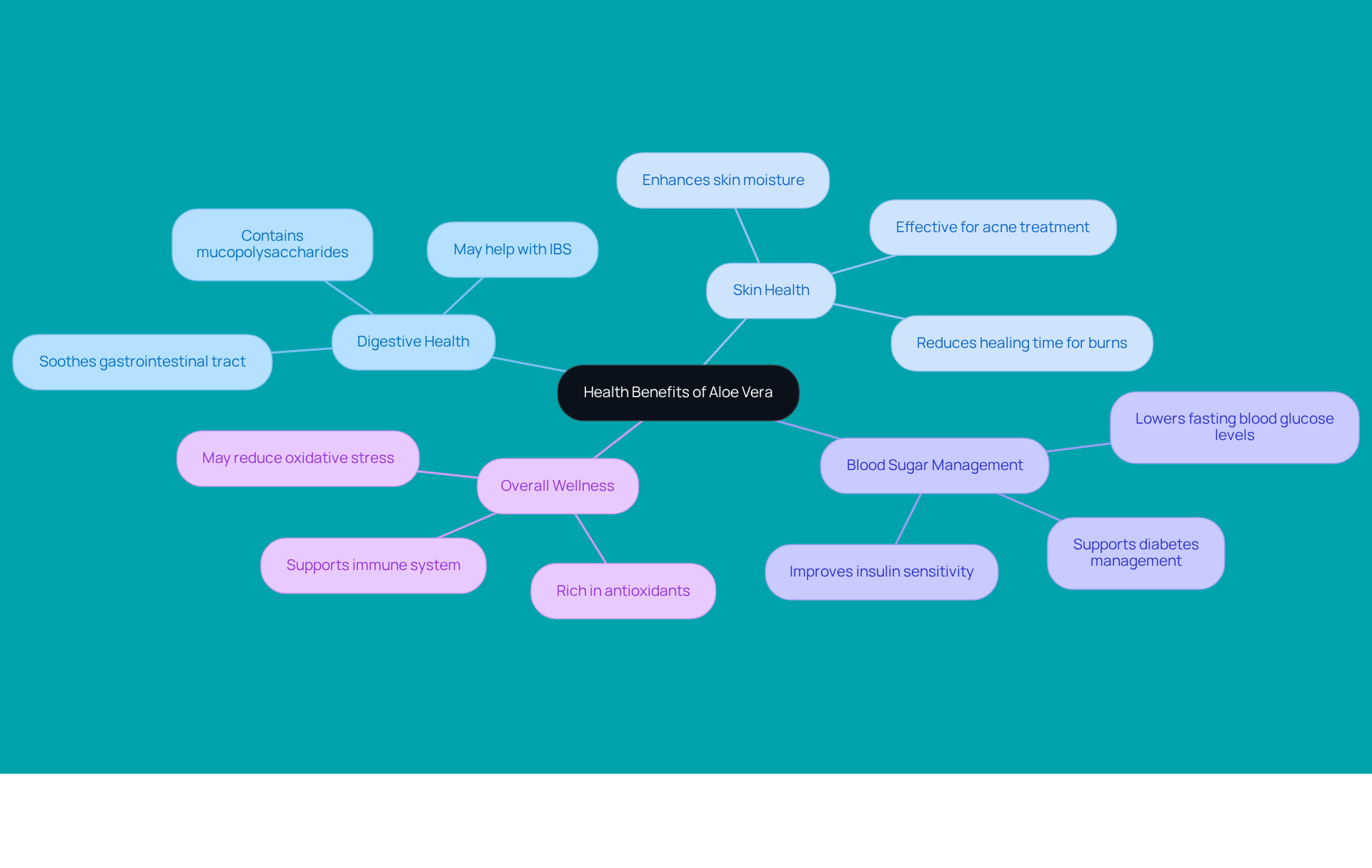Overview
Aloe vera offers a wealth of health benefits that many of us seek, such as improved digestive health, enhanced skin conditions, and even potential blood sugar regulation. Imagine if you could incorporate something so natural into your wellness routine!
However, it’s essential to focus on the clear gel of the plant while steering clear of the latex. This distinction is crucial for ensuring you reap the benefits safely. You might be wondering about the best way to include aloe vera in your diet. Consulting with healthcare professionals is a wise step, especially if you have allergies or pre-existing conditions. This way, you can confidently embrace aloe vera as part of your journey towards better health.
Together, let’s prioritize our well-being by making informed choices. By understanding how to use aloe vera safely, you can take a significant step towards enhancing your health.
Introduction
Aloe vera, often celebrated as the 'plant of immortality,' carries a rich history and a wealth of wellness benefits that many seek to incorporate into their diets. This remarkable succulent not only supports digestive health and skin vitality but also provides a host of nutritional advantages, including essential vitamins and minerals.
However, you might be wondering how to safely enjoy all that aloe vera has to offer while being mindful of potential risks. It’s important to approach this superfood with care. This guide is here to help you navigate the best practices for consuming aloe vera, highlighting its many advantages, culinary uses, and necessary precautions to ensure a healthy and enjoyable experience.
Imagine if you could enhance your meals with a natural ingredient that not only tastes great but also boosts your well-being. Together, let’s explore how to make aloe vera a delightful part of your wellness journey!
Understand Aloe Vera: Origins and Nutritional Profile
Aloe, often celebrated as the 'plant of immortality,' has a rich history that goes back to ancient Egypt, where it was cherished for its incredible healing properties. This succulent thrives in dry climates, showcasing thick, fleshy leaves filled with a soothing clear gel.
You might be wondering about its nutritional benefits. Well, aloe is a low-calorie powerhouse, packed with essential vitamins like A, C, and E—known for their strong antioxidant properties. Plus, it’s loaded with vital minerals such as calcium, magnesium, and potassium, along with amino acids and enzymes that enhance its wellness advantages. Recent studies reveal that this remarkable plant contains over 75 active compounds, solidifying its status as a superfood.
Imagine learning how to eat aloe vera and incorporating it into your daily routine. It’s been shown to support digestive health and may even help manage blood sugar levels, making it a valuable ally in your wellness journey. Additionally, aloe can reduce recovery time for burns by about 9 days compared to traditional therapies, showcasing its practical applications.
However, it’s crucial to remember that this information isn’t medical advice. If you have allergies to garlic, onions, or tulips, please consult a healthcare professional before using aloe. Understanding how to eat aloe vera along with these nutritional factors is essential for anyone looking to maximize the benefits of this plant in their wellness journey. Together, let’s explore how aloe can support your health!

Explore the Health Benefits of Aloe Vera
Aloe is well-known for its numerous wellness benefits, particularly when it comes to digestive health. Imagine if you could soothe your gastrointestinal tract and promote regularity while alleviating discomfort. That’s exactly what this remarkable plant can do! Studies suggest that aloe not only enhances skin moisture but also effectively addresses issues like acne and sunburn, thanks to its anti-inflammatory properties. A systematic review even shows that aloe can speed up the healing of mouth ulcers, highlighting its skin health benefits.
But that’s not all! This succulent plant has also been linked to improved blood sugar levels, making it a valuable ally for those managing diabetes. You might be wondering how it works—research indicates that aloe can enhance insulin sensitivity and lower fasting blood glucose levels, offering a natural solution for blood sugar management. Plus, its rich antioxidant content, along with Vitamin C, helps combat oxidative stress and supports a strong immune system, boosting overall wellness and vitality.
However, it’s important to note that some individuals may experience gastrointestinal upset when consuming aloe juice. By learning how to eat aloe vera and incorporating this succulent into your diet, you can harness its benefits to support your health journey. Together, let’s explore how aloe can be a nurturing addition to your wellness routine!

Incorporate Aloe Vera into Your Meals: Practical Tips and Recipes
Incorporating succulent plants into your meals can be a delightful and beneficial experience, particularly when you understand how to eat aloe vera. Let’s explore some practical tips that can enhance your culinary journey:
Smoothies: Imagine starting your day with a refreshing boost! Just add a tablespoon of gel from the succulent plant to your morning blend to discover how to eat aloe vera. It pairs wonderfully with fruits like mango and banana, creating a deliciously revitalizing drink.
Salads: Looking to add a delightful crunch to your salads? To learn how to eat aloe vera, dice fresh succulent gel and toss it in! It complements citrus dressings beautifully, enhancing both texture and nutritional value. To understand how to eat aloe vera for a flavorful dressing, mix the gel with olive oil, vinegar, mustard, salt, and pepper.
Drinks: You might be wondering how to stay hydrated in a tasty way. To learn how to eat aloe vera, blend plant sap with lemon juice and water for a refreshing beverage. If you like a touch of sweetness, honey works wonders!
Treats: Want to add a unique twist to your sweets? You can learn how to eat aloe vera by incorporating plant gel into popsicles or sorbets for a delicious treat that also offers health benefits.
Recipe Example: Aloe Vera and Mango Smoothie
- Ingredients: 1 cup mango chunks, 1 tablespoon aloe vera gel, 1 cup coconut water.
- Instructions: Blend all ingredients until smooth and enjoy a refreshing drink packed with nutrients, which is a great way to learn how to eat aloe vera. This smoothie not only hydrates but also supports digestion, making it a perfect addition to your health-focused meals.
Unique Salad Recipe: Aloe Vera Shrimp Salad
- Ingredients: Fresh aloe vera gel, shrimp, jellyfish, mango, carrots, cucumber.
- Instructions: Combine all ingredients in a bowl, toss with a light dressing, and serve chilled for a refreshing dish that demonstrates how to eat aloe vera while showcasing its versatility.
Together, let’s embrace the benefits of succulent plants in our meals and take a step towards a healthier lifestyle!
Recognize Risks and Precautions When Consuming Aloe Vera
While the succulent plant is often celebrated for its many wellness benefits, it’s crucial to approach its intake with care. Let’s explore some important risks and precautions together:
- Avoid Aloe Latex: The latex extracted from the outer leaf has strong laxative properties due to its anthraquinones content, which can lead to uncomfortable abdominal cramps and diarrhea. It’s best to stick with the clear gel for consumption.
- Moderation is Key: Consuming large amounts of the plant can lead to gastrointestinal discomfort and may even result in acute kidney failure or electrolyte imbalances. Starting with small amounts is a wise way to gauge your body’s tolerance.
- Consult a Healthcare Provider: If you’re pregnant, nursing, or have pre-existing health conditions—or if you’re on medications like blood thinners or diabetes treatments—please seek guidance from a healthcare professional before adding this plant to your diet.
- Allergic Reactions: Some individuals may experience allergic responses to the plant, particularly those who are sensitive to its components. It’s important to keep an eye out for any adverse effects, especially when trying it for the first time.
By understanding these precautions, you can safely enjoy the potential benefits of aloe vera while minimizing risks. Remember, your wellness journey is important, and taking these steps can help you feel more confident in your choices.

Conclusion
Aloe vera truly shines as a remarkable plant, boasting a rich history and a wealth of health benefits that can be a wonderful addition to your wellness routine. Imagine how incorporating aloe into your daily meals could enhance your digestive health, support skin rejuvenation, and even help manage blood sugar levels. By embracing the versatility of aloe vera, you can experience a refreshing boost to your overall well-being.
This article sheds light on the nutritional profile of aloe vera, highlighting its abundance of vitamins, minerals, and active compounds that contribute to its superfood status. You might be wondering how to enjoy these benefits—practical tips for adding aloe to smoothies, salads, and other dishes show just how easy it can be. However, it’s crucial to recognize the precautions necessary for safe consumption, such as steering clear of aloe latex and consulting healthcare professionals if you have any underlying health concerns.
Incorporating aloe vera into your diet isn’t just about savoring its taste; it’s about making informed choices that can lead to a healthier lifestyle. As we continue to explore this incredible plant, understanding both its benefits and risks becomes essential. By taking the time to learn how to eat aloe vera safely and effectively, you can harness its full potential, paving the way for improved health and vitality in your everyday life. Together, let’s embark on this journey toward wellness!
Frequently Asked Questions
What is aloe vera commonly known as?
Aloe vera is often celebrated as the 'plant of immortality' due to its rich history and incredible healing properties.
Where did aloe vera originate, and what is its natural habitat?
Aloe vera has a rich history that goes back to ancient Egypt and thrives in dry climates.
What are the nutritional benefits of aloe vera?
Aloe vera is a low-calorie powerhouse packed with essential vitamins A, C, and E, vital minerals like calcium, magnesium, and potassium, as well as amino acids and enzymes.
How many active compounds are found in aloe vera?
Recent studies reveal that aloe vera contains over 75 active compounds, solidifying its status as a superfood.
How can aloe vera support digestive health?
Aloe vera has been shown to support digestive health and may help manage blood sugar levels.
What practical applications does aloe vera have for burns?
Aloe vera can reduce recovery time for burns by about 9 days compared to traditional therapies.
Is the information about aloe vera considered medical advice?
No, the information provided is not medical advice. It is recommended to consult a healthcare professional if you have allergies to garlic, onions, or tulips before using aloe.
How can one incorporate aloe vera into their daily routine?
Learning how to eat aloe vera and understanding its nutritional factors is essential for maximizing its benefits in your wellness journey.




